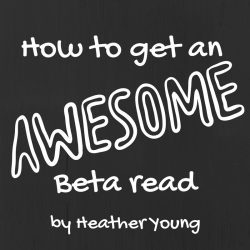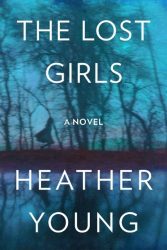Guest Post: 4 Tips For Getting A Great Beta Read by Author Heather Young
What writer doesn’t benefit from a great beta read? Whether it’s your first novel or your tenth, feedback from one (or more) trusted readers who provide the feedback you need the way that you need it, is key.
Today we’re getting some great tips on how to get what you need from a beta reader from debut author Heather Young, whose novel THE LOST GIRLS was released by William Morrow on July 26th. Here’s what folks are saying about THE LOST GIRLS. “Beautifully written, THE LOST GIRLS will please suspense fans as well as those who love redemptive fiction. This is a big, bold, heart-wrenching book reminiscent of novels by Jodi Picoult, and is an excellent debut.” —Bookreporter.com
What are you beta reader experiences? What are your tips for making sure you get what you need? Share in the comments — and please welcome Heather Young to WFW!
Amy xo

 After five years writing The Lost Girls, I finally had a draft I thought was close. But I’d been staring at it for so long that I worried I was missing some huge, glaring flaw. What if my big reveal had been telegraphed in chapter three? What if my protagonist was unlikeable? What if the story dragged in the middle? I honestly didn’t think I could tell anymore.
After five years writing The Lost Girls, I finally had a draft I thought was close. But I’d been staring at it for so long that I worried I was missing some huge, glaring flaw. What if my big reveal had been telegraphed in chapter three? What if my protagonist was unlikeable? What if the story dragged in the middle? I honestly didn’t think I could tell anymore.
Then I heard about “beta readers” — people who read your book with a fresh eye and point out everything that’s wrong with it. So I went out and found a couple. And they did, in fact, point out flaws I hadn’t seen. For another six months I revised with their comments in mind, and the book was stronger for it. I’m now a firm believer that beta readers are an invaluable tool in the writerly toolbox.
However, beta readers occupy a tiny Venn diagram comprised of people who (1) have never read your book, (2) are willing to devote a big chunk of time to it, and (3) will give you an honest opinion that you value, which means you only get so many chances at them. After my own experiences getting and giving beta reads, I’ve come up with some thoughts on how to make the most of those precious opportunities.
First, of course, you have to find the people in that Venn diagram. Ideally, you’ll find both a writer and a non-writer. The writer will read through a craft lens and give you craft-based suggestions, while the reader will give you a sense of how your book would be received in the world. It’s a nice balance.
Then, once you’ve got them, it’s important to clearly define the parameters of what you’re asking them to do. After all, they’re going to spend a lot of time on this, and you want to make sure you get what you need from them. Here are some examples of things you might tell them:
1. Ask for Real-Time Commentary
When I do a beta read, the first thing I do is read the manuscript all the way through and write my unfiltered reactions in the margins. (I use TrackChanges for this, but a pen works just as well!) I point out where I’m confused. I record my emotional responses, such as whether I’m liking a character, whether a plot point feels surprising or contrived, and when I’m feeling mounting tension. I also note when I disconnect from the page, and anything else that springs to mind as I read. Not until the second read do I add more traditional editorial comments.
The writers I’ve done this for tell me that having those real-time notes is a tremendous help in gauging whether their writing is provoking the responses they want in a virgin reader. It does add an extra step, but because the data is so valuable, you may want to ask your readers to do the same.
2. Ask for an Edit Letter
It’s tempting to take your beta reader out for a drink and have her tell you what she thinks, but I found it was better to have it in writing. Not only could I refer to it later, but in my own beta reading, writing my thoughts down helps me distill them into something more coherent. Plus, if your beta reader doesn’t have to criticize your book to your face, she’ll be more willing to tell you about the Dead Zone between pages 75 and 130.
3. Keep Them Focused on the Big Picture
A beta read is about getting perspective on how your novel is working overall, not about the prose itself. This is a difficult distinction for some readers to grasp (especially the writers!), so tell them not to worry about typos, and definitely tell them whether you want line edits. I asked my beta readers not to do them, because I wanted them to look only at structural, thematic, pacing, and character issues. But I have done them in my own beta reads, and you may want them – or you may want them from some readers and not from others.
4. Don’t Ask for Specific Insights
I don’t recommend asking for specific feedback up front, such as whether a particular subplot is working or whether your protagonist’s actions are believable. That’s going to skew the way they read, and I think the most helpful beta reads are utterly fresh and unbiased by the writer’s worries. You can always ask those questions after they’ve read it.
Finally, when it’s all over, send your beta readers a present. Doing a beta read takes a lot of time, and it’s of enormous benefit to you, so a bottle of tequila or a tote bag is definitely in order. And don’t forget to thank them in your acknowledgements! Trust me, they’ll look!
 Heather Young grew up in Maryland, but has lived in the San Francisco Bay Area since 1991, with her two teenaged children and her husband. She’s also strongly rooted in the Midwest: her parents grew up in small Iowa towns and met at the University of Iowa. Though they raised their children in the Washington, D.C., area, they brought them to Minnesota every summer. It’s this emotional connection that Heather drew upon to create the characters, events, and settings in THE LOST GIRLS.
Heather Young grew up in Maryland, but has lived in the San Francisco Bay Area since 1991, with her two teenaged children and her husband. She’s also strongly rooted in the Midwest: her parents grew up in small Iowa towns and met at the University of Iowa. Though they raised their children in the Washington, D.C., area, they brought them to Minnesota every summer. It’s this emotional connection that Heather drew upon to create the characters, events, and settings in THE LOST GIRLS.Heather received an MFA from the Bennington Writing Seminars in 2011. When she’s not writing, she loves biking, hiking, skiing, and reading books she wishes she’d written.
Twitter: @HYoungwriter
Facebook: www.facebook.com/heatheryoungwriter
Website: www.heatheryoungwriter.com
Women's Fiction Writers
- Amy Sue Nathan's profile
- 543 followers



